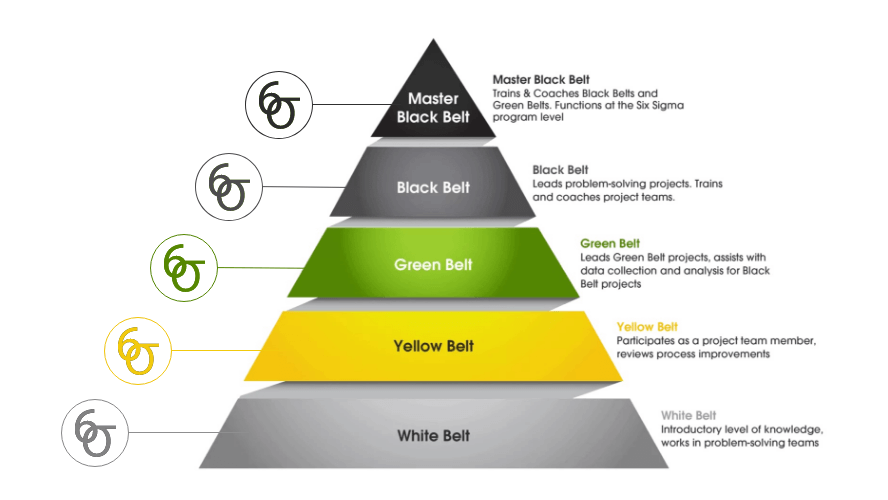Six Sigma is a business improvement technique initially employed in the 1980s by firms such as Motorola and Honeywell. In the 1990s, many Fortune 500 companies adopted Six Sigma to improve productivity (and profits) by removing the causes of problems with service, defects, and waste. Nowadays, businesses in nearly every industry utilize Six Sigma to improve their efficiency, bottom line, and customer satisfaction.
Each Six Sigma project is managed with tools and techniques used in five phases, known in the DMAIC Methodology: Define, Measure, Analyze, Improve, and Control. Utilizing the statistical method, Six Sigma teams work to make processes more efficient and 99.997 100% defect-free. This is equivalent to just 3.4 errors per million.
Six Sigma projects are managed by people with specific names, roles, and certificates. These roles are defined by an orderly belt structure, which includes darker belts that represent the roles that require education and experience. The yellow belt is white, while the belts are green, black, green, and master black.
White Belts
Six Sigma white belts work at the earliest level in this Six Sigma process and understand Six Sigma concepts. They are responsible for collaborating with the next belt (green belts) to address specific issues at the local level. In most cases, white belts are required to assist in the all-encompassing Six Sigma project. Still, they aren't necessarily part of the Six Sigma team.
Certificate: Neither of the most well-known Six Sigma certifying organizations, the International Association for Six Sigma Certification (IASSC) or the American Society for Quality (ASQ), provide a Six Sigma white belt certification. However, some schools and companies offer this type of certification.
Yellow Belts
Six Sigma Yellow Belts are the first step towards Six Sigma certification. The yellow belts comprise Six Sigma team members who work under green belts. They are familiar with the fundamentals of Six Sigma and the three initial stages that include the DMAIC framework: define, measure, and analyze. Yellow belts are accountable for evaluating the process improvement needed to support the Six Sigma project.
Certificate: To obtain a Yellow Belt certification, you must pass a twenty-question test.
Green Belts
Six Sigma Green Belts typically sit at the level of the manager. They are accountable directly to Six Sigma black belts. They are considered to be the workers of a Six Sigma project because they are the ones who do the majority of data analysis and collection work. Green belts are well-versed in all aspects of DMAIC's framework. Green belts with experience can manage small Six Sigma projects.
Certificate: To obtain a Six Sigma green belt certification, you must have at least one year of working experience in any of the areas within the Six Sigma Green Belt Body of Knowledge (e.g., improvement of processes), and this experience must be with a pay-per-hour position. It is also necessary to pass the 1-hour green belt exam, which is a 50-question test.
Black Belts
Six Sigma Black Belts are the leaders of Six Sigma projects, green belts, and teams. These can be Six Sigma experts with vast knowledge. Black belts communicate with senior executives and ensure Six Sigma project goals are achieved.
Certificate: To obtain a Six Sigma black belt certification, you must have Green Belt experience and completed 2 Six Sigma projects with signed affirmations. In addition, you must be able to pass the 1-hour test that includes 50 questions.
Master Black Belts
Six Sigma Master Black Belts are coaches and trainers for those with lower belts. Their work is usually focused on strategic issues rather than project-based. It explicitly focuses on Six Sigma at the program and enterprise levels.
Certificate: To obtain a Six Sigma master black belt certification, you must possess five years' work experience as a Six Sigma black belt or at least 10-completed Six Sigma black belt projects. Additionally, you must pass a two-part test.
Other Six Sigma Roles
In addition to Six Sigma belt designations, businesses generally include Six Sigma executives and champions. The Six Sigma executive's role is to integrate their Six Sigma program with the business's strategy and culture. The leader translates the vision and objectives into a complete Six Sigma program and individual initiatives.
Each of these roles is essential in ensuring that Six Sigma effectively improves a company's profitability and profits.






